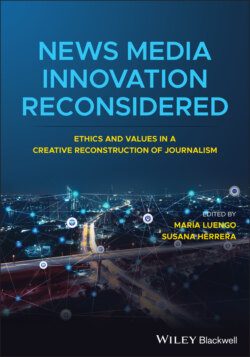Читать книгу News Media Innovation Reconsidered - Группа авторов - Страница 40
Timid Reporting or Biased Engagement
ОглавлениеDemocratically engaged journalism claims to be a third way between neutrality and partisanship. However, some readers may still worry that it can be used to justify biased “engagement.” In fact, I claim that democratically engaged journalism has the means to avoid two ills of contemporary journalism: (1) an excessive timidity in opposing falsehood and manipulative communicators in the public sphere due to a commitment to neutrality and detachment; and (2) an aggressive, biased engagement, where people use journalism to promote dubious causes by using dubious means, such as twisting the facts or circulating conspiracy theories. That there are unethical forms of journalistic engagement is clear from Figure 2.1, which contains such unethical uses as propaganda.
With respect to timidity, the negative consequences of subscribing to a journalism ethics tethered to a strict neutrality that reports “just the facts” is clear from watching mainstream news organizations' attempt to deal with false or intolerant statements by leaders or groups. For example, since Donald Trump was elected president, American mainstream reporters, seeking to honor a traditional news objectivity, have twisted themselves into verbal pretzels trying not to call an outrageous statement by Trump racist, or hate speech, or misogynist. Better to see if someone else, like a liberal professor, will say so. At the same time, partisans use the media’s commitment to “balance” to create false moral equivalencies between racist and anti-racist groups.
Trump, in July of 2019, told four Congresswomen of color that they should “go home” because they criticized US policy, even though all were American citizens. His storm of tweets against the women received much play. Rather than call his comments racist, CBS and the Times settled for a euphemism. It called them “racially charged” speech. Others said the comments might affect “racial divisions” but stopped short of saying they were racist. Other outlets fell back on the plaintive cry, “this is not who we are,” which only fails to come to grips with the depth of racism in the country. In this topsy-turvy world, Trump supporters then used the media’s notion of balance to get publicity for their accusation that it was the women who were racist.29 So, I ask: Whence this reticence to state the obvious, that such statements are racist, when the “go-back-where-you-came-from” slur is an age-old racist adage? It is a longstanding strategy of American white supremacists to paint people of color and non-Christians as unwelcome strangers in their own country. The answer is: a commitment to a narrow conception of good reporting as necessarily neutral and “facts only.” This conception makes it very difficult for reporters to call a president a liar or a racist, even if there is evidence for that charge.
The ideology of democratically engaged journalism does not hold the extreme positions that reporters should never be neutral, or should report continually in an opposition mode, calling people liars or racists, or taking sides in a prejudicial manner. There are types of stories, such as a criminal trial, where reporters should attempt a neutral description of the evidence presented by both the prosecutor and the defense lawyer. Moreover, journalists should swing into their strong, oppositional stance where the situation requires such a position, e.g., if Trump refuses to step down as president even though he were to lose the next federal election. In crucial cases where anti-democratic ideas are advanced, journalists should greet it with active opposition, not balance. But not every story requires such engagement. However, where principles of equalitarian democracy are at stake, journalists should not be hampered by scruples over neutrality or reporting “just the facts.”30 If a statement is a lie or racist, then say so. If a spokesperson’s description of refugees is factually inaccurate, misleading, and demeaning, then say so. And say so in news coverage and analysis, not just in editorials inside newspapers. Just be ready to back it up with solid evidence, not bias or partisanship.
